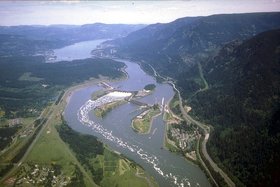Bonneville Dam
|
|
Bonneville Lock and Dam is several dam structures that together complete a span of the Columbia River between the US states of Oregon and Washington at River Mile 146.1. The dam is located 40 miles east of Portland, Oregon, in what is now the Columbia River Gorge National Scenic Area. The primary functions of Bonneville Lock and Dam are those of electrical power generation and river navigation. The dam was built and is managed by the US Army Corps of Engineers. Electrical power generated at Bonneville is distributed by the Bonneville Power Administration. Bonneville Lock and Dam is named for Army Capt. Benjamin Bonneville, an early explorer credited with charting much of the Oregon Trail.
| Contents |
History
The original structures: a lock and powerhouse constructed on the south (Oregon) side of Bradford Island and a spillway on the north (Washington) side, were built by the Army Corps of Engineers during the New Deal—started in 1933 and finished in 1937. Prior to this damming of the river, a set of locks that were opened in 1896 moved ships around Cascades Rapids, located several miles upstream of Bonneville (see Cascade Locks, Oregon). Both the cascades and the old lock structure were submerged by Lake Bonneville, the reservoir that formed behind the dam. The original navigation lock at Bonneville was opened in 1938 and was, at that time, the largest single-lift lock in the world.
In his song Roll on, Columbia, the folk singer, Woody Guthrie, spoke of Bonneville as follows:
- At Bonneville now there are ships in the locks,
- The waters have risen and cleared all the rocks,
- Shiploads of plenty will steam past the docks,
- So roll on, Columbia, roll on.
At the time, America was in the Great Depression, and the dam's construction provided important jobs and money for the Pacific Northwest, providing hydropower that gave cheap energy to aluminum plants in the area, and enabling transportation 188 miles up the Columbia.
A second powerhouse (and dam structure) was started in 1974 and completed in 1981. The second powerhouse was built by widening the river channel on the Washington side, creating Cascades Island between the new powerhouse and the original spillway. The combined electrical output of the two power houses at Bonneville is now over 1 million kilowatts.
Despite its world record size in 1938, Bonneville Lock became the smallest of seven locks built subsequently at different locations upstream on the Columbia and Snake Rivers; eventually a new lock was needed at Bonneville. This new structure was built on the Oregon shore, opening to ship and barge traffic in 1993.
Dimensions and statistics
- First Powerhouse – Constructed in 1933-37; 313 m (1,027 ft) long; 10 generators with an output capacity of 526,700 kW.
- Spillway – Constructed 1933-37; 18 gates over a length of 442 m ( 1450 ft); maintains the reservoir (upriver) usually 18 m (60 ft) above the river on the downsteam side;
- Second Powerhouse – Constructed 1974-81; 300.5 m (986 ft) long; 8 generators (plus two at fish ladders) with a total generating capacity of 558,200 kW.
- Bonneville Lock – Constructed in 1993 at a cost of $341 million; 26 m (86 ft) wide, 206 m (675 ft) long; transit time is approx. 30 minutes.
- Lake Bonneville – 77 km (48 mi) long reservoir on the Columbia River created by Bonneville Dam; part of the Columbia-Snake Inland Waterway.
References
- Bonneville Lock and Dam. A National Historic Landmark Serving the Northwest. 2001. U.S. Government Printing Office, 2001-691-677. U.S. Army Corps of Engineers, Portland District, public information pamphlet distributed at the Bonneville Lock and Dam visitor centers.
External links
- U.S. Army Corps of Engineers - Bonneville Lock and Dam (https://www.nwp.usace.army.mil/op/b/)
- Bonneville Power Administration (http://www.bpa.gov/corporate/kc/home/index.cfm)
- Dams of the Columbia Basin & Their Effects on the Native Fishery (http://www.ccrh.org/comm/river/dams.htm)



